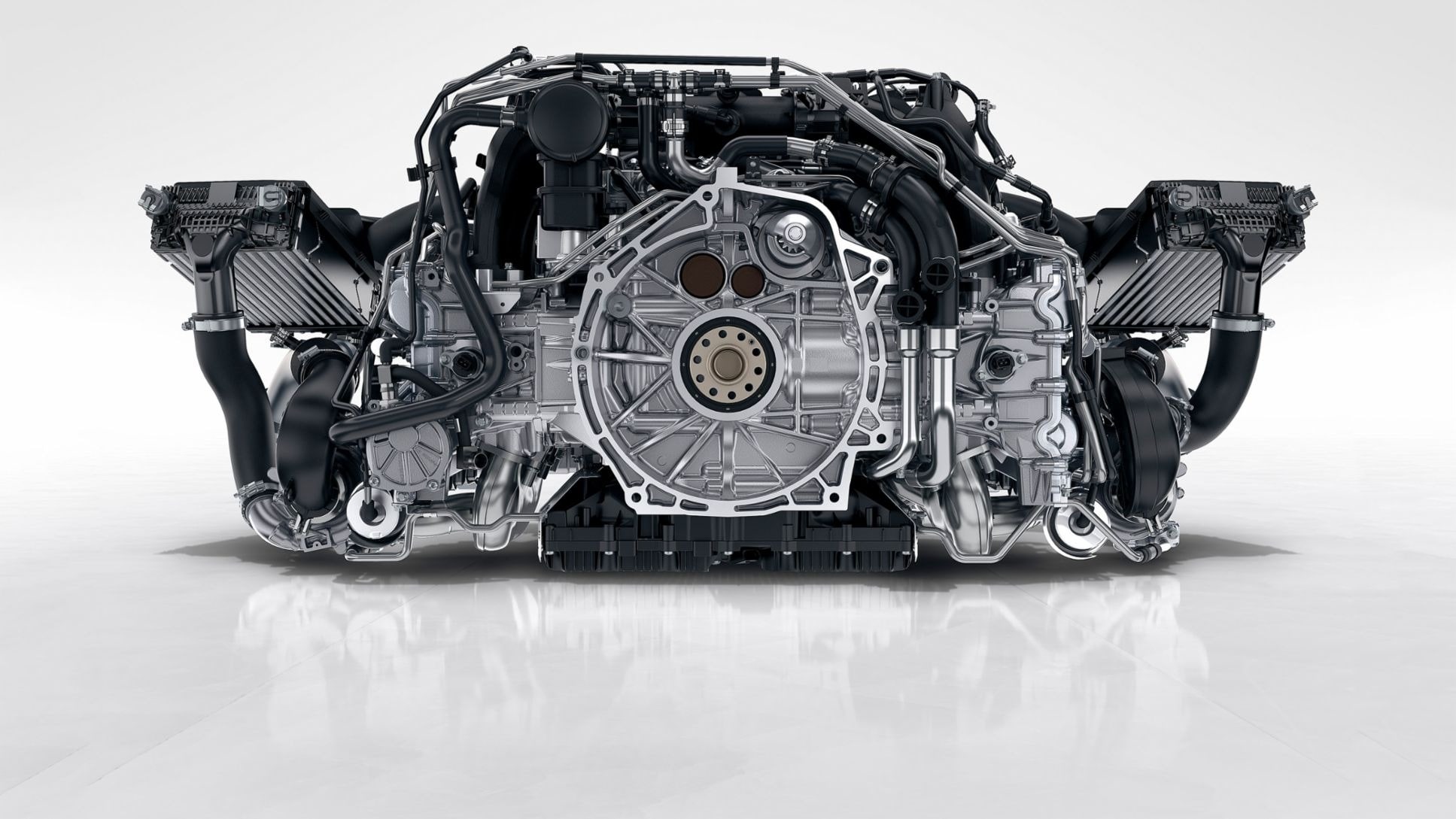
Porsche's commitment to flat engine design dates back seven decades. This innovative engine design defines the unadulterated performance and character of Porsche's legendary sports cars and is regarded as an engineering masterpiece.
Karl Benz invented this engine configuration in 1897 as the "kontra engine." In 1963, it became a cornerstone of Porsche's engineering philosophy when it started producing flat-six engines with power output ranging from 110-850 horsepower. Since launching the Porsche 356, the brand has worked tirelessly to refine and perfect the flat engine design, particularly in the iconic 911 series. The design is hugely beneficial for sports car performance because it provides a low center of gravity and excellent handling. In this guide, our team at Porsche Livermore, California, will explain the details and benefits of the Porsche boxer engine.
Understanding the Basics: What Is a Flat Engine?
A flat engine, also known as a boxer or horizontally opposed engine, features a distinct configuration where the cylinders lie horizontally on opposite sides of the crankshaft. In this design, the pistons move toward and away from each other in a horizontal plane, similar to the motion of a boxer's fists — hence the "boxer engine" nickname.
The opposing pistons move inward and outward at the same time. This natural balancing act means there's no need for additional balance shafts or heavy counterweights. As a result, drivers experience smoother operation and less vibration than in other engine configurations.
While building flat engines with any number of cylinders is possible, the brand is known for the Porsche flat-six engine. This design provides the ideal balance of power, smoothness, and the characteristic sound that Porsche enthusiasts have come to love.
Porsche's History With Flat Engines
Ferdinand (Ferry) Porsche's early work with air-cooled engines laid the foundation for what would become a defining feature. The evolution of Porsche's flat engine technology includes several significant milestones:
- 1948: Ferry Porsche installed a modified 1.1-liter Volkswagen Beetle four-cylinder boxer engine in the Porsche 356/1, which produced 35 horsepower.
- 1963: Porsche launched the Porsche 911 with its own flat-six engine design.
- 1974: Porsche integrated turbo technology to increase the power output.
- 1999: Porsche shifted from air-cooled to water-cooled engines in their 911 models. This move allowed for increased horsepower and thermal control.
Benefits of Flat Engines in Porsche Vehicles
The flat engine configuration provides many benefits that align with Porsche's performance objectives.
Low Center of Gravity
The flat engine design allows for a low center of gravity, improving vehicle stability, traction, and handling, especially in rear-engined vehicles, such as the 911. This benefit is particularly noticeable in high-speed cornering situations.
Balanced Design
The balanced design of the flat engine contributes to its smooth operation. The opposing pistons naturally cancel the other's vibrations. This smoothness contributes to both driver comfort and mechanical longevity. The compact vertical profile of flat engines allows Porsche to design vehicles with lower hood lines to improve aerodynamics and visibility.
Impressive Performance
Modern Porsche flat engines have impressive performance capabilities. For example, the naturally aspirated 3.8-liter flat-six engine produces 300 horsepower, while turbocharged versions generate up to 450 horsepower. The torque output of Porsche's flat-six engines ranges from 119 to 730 lb-ft.
Advanced technologies, such as variable cam plus systems and direct fuel injection in flat boxer engines, result in increased power output and superior performance. The flat engine's lightweight construction is not just high-performing but efficient, too. The charge cycles result in high specific output and reduced fuel consumption as engine power increases.
Frequently Asked Questions
Our team has compiled a list of FAQ relating to Porsche's flat-six engines.
What's the Difference Between a Flat Engine and Other Configurations?
Flat engines spread their cylinders horizontally, unlike V-shaped or inline engines, which have vertically oriented cylinders. This layout results in a better weight distribution than traditional engine designs.
Do All Porsche Models Have a Flat Engine?
No. While Porsche is famous for its flat engines, not all models use this configuration. Some Porsche SUVs and sedans have V-6 or V-8 engines to meet different vehicle requirements. However, the flat-six engine remains a defining feature of Porsche's sports car lineup, particularly in the 911 series.
Are Flat Engines Reliable?
Yes. While flat engines can be more complex to work on because of their wider footprint and cylinder placement, Porsche designs its modern flat engines for durability and serviceability. The transition to water cooling has improved long-term reliability and performance consistency.
The Future of Flat Engines at Porsche
Porsche continues to innovate its flat engine design, adapting it for modern performance and efficiency. The 2024 911 Carrera GTS is the latest evolution. It features a 3.6-liter flat-six engine that produces 478 horsepower and 420 lb-ft of torque. This new powertrain incorporates advanced hybrid technology, including an electrically assisted turbocharger and a 1.9 kWh battery system.
The hybrid system adds up to 40 kW of electric motor power and 150 lb-ft of additional torque. An innovative exhaust energy recovery system can generate up to 11 kW of electricity to improve overall efficiency. The new electric turbocharger is designed to remove traditional turbo lag and improve the Porsche's response and performance.
Experience the Thrill For Yourself at Porsche Livermore
As the automotive industry evolves, Porsche shows how flat engine technology can adapt to meet modern challenges — without sacrificing the power the brand is known for. The combination of a low center of gravity, natural balance, and high performance makes the flat engine an ideal choice for Porsche's sports cars. To experience the thrill and engineering marvel of Porsche's flat-six engines for yourself, visit Porsche Livermore for a test-drive or to learn more about these iconic vehicles from our experienced team.